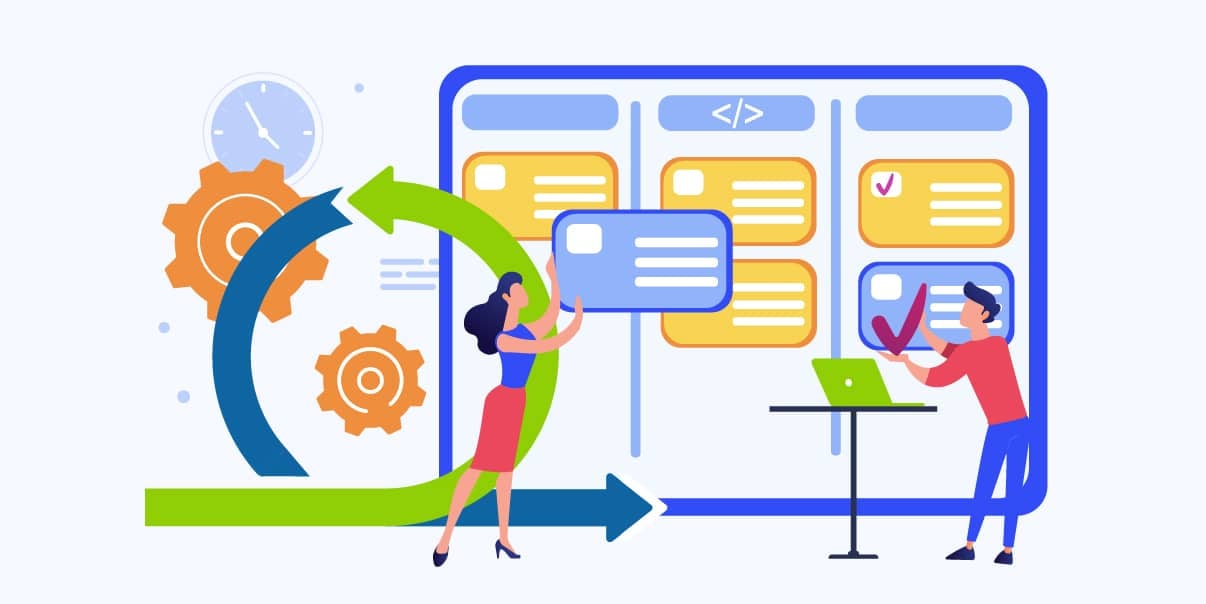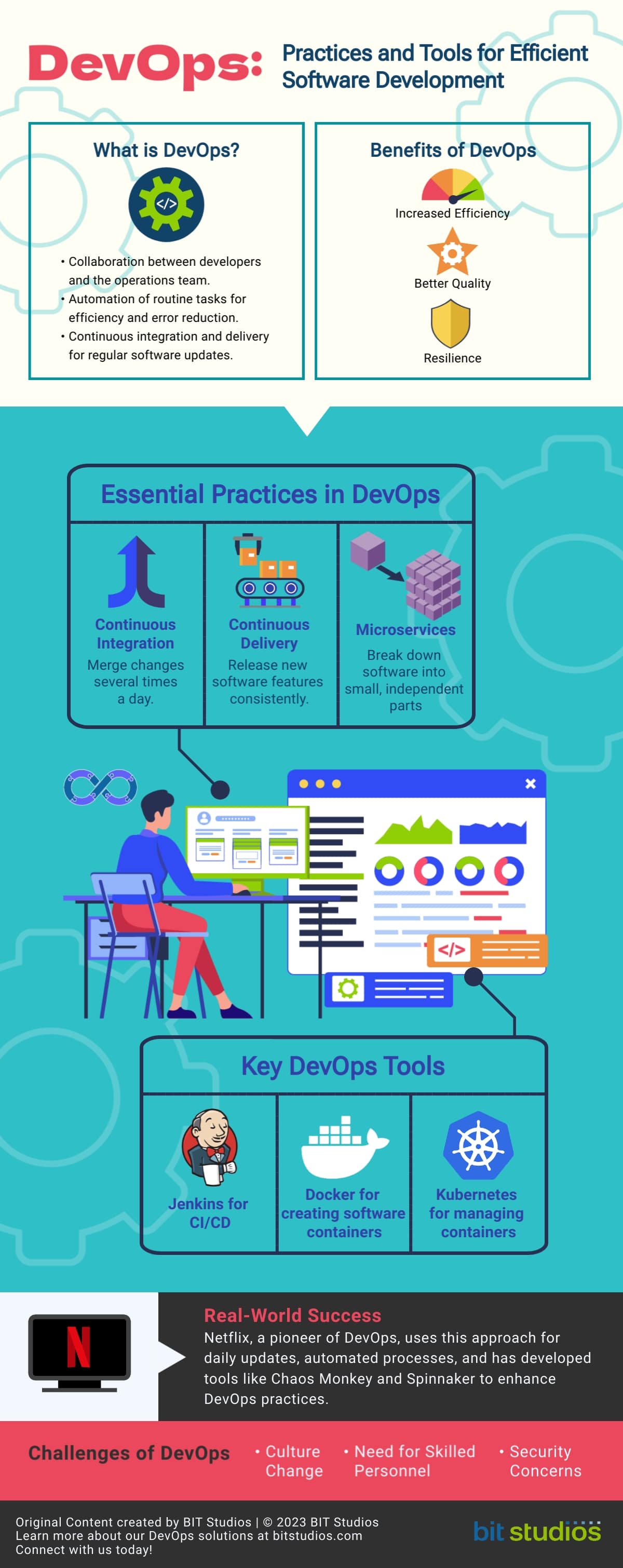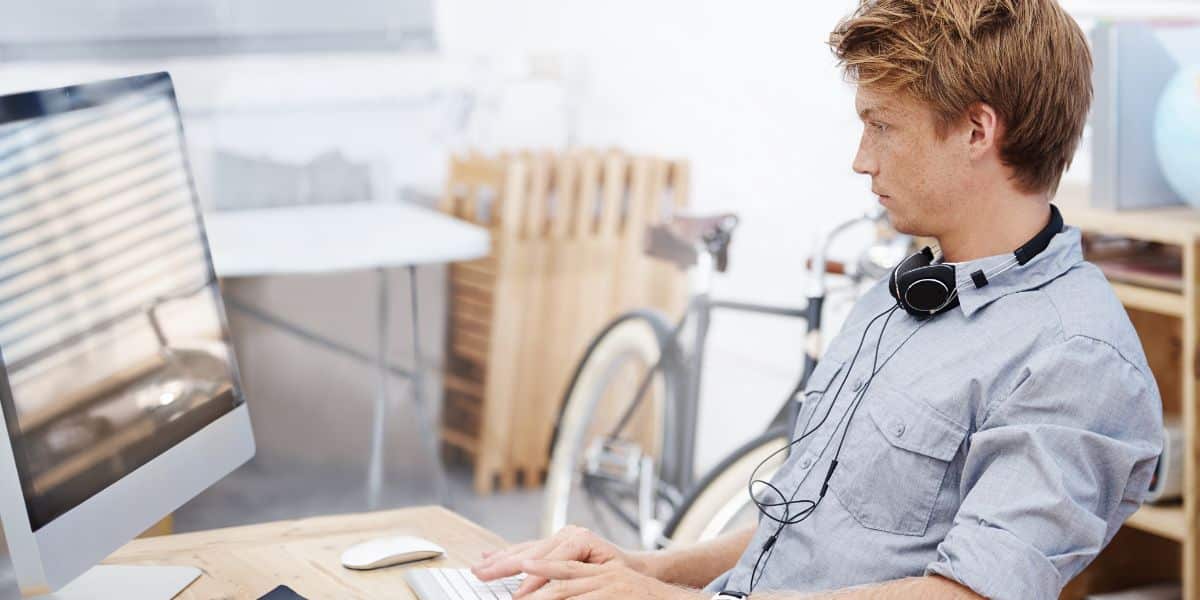Software Development Methodologies
8 Proven Techniques for Enterprise Success

When making software, picking the suitable method can make a big difference. Different software development methodologies present distinct approaches with unique strengths, weaknesses, and suitability for specific projects. So, making an intelligent choice is very important.
This article will help you understand eight popular ways to develop software. We’ll explain what they are, why they’re good, their real-life examples, and their challenges.
Whether you’re a small startup, a tech company, or a big corporation, you’ll find a method that fits your needs. Now, let’s learn about the popular software development methodologies.
1. Agile Methodology
Agile methodology is a rapid development process where solutions evolve through the collaboration of self-managing teams. It encourages flexible responses to changes and promotes iterative work sequences known as sprints.
Agile operates on a set of values and principles in the Agile Manifesto. Here are its four fundamental principles:
- Customer Satisfaction. The highest priority is to make the customer happy by continuously delivering valuable software.
- Welcoming Change. Even late in development, Agile welcomes changes if they benefit the customer.
- Deliver Working Software. In Agile, regularly providing small, workable software parts is essential.
- Cooperation. Unlike in other software development methodologies, developers and business people must work closely together throughout the project in Agile.
Benefits of Agile for Startups and Small Businesses
Agile methodology offers several benefits for the development team of startups and small businesses. It lets them quickly change plans, which is good when things constantly change. It helps them keep up with customer expectations through continuous refinement.
Agile software development methodology always aims to deliver functional software. So, it ensures that a product continuously improves throughout the software development process.
These are other benefits of Agile methodology for startups and small businesses:
- Reduced Risk. Regular reviews and incremental development in Agile help catch issues early, reducing the risk of project failure.
- Better Product Quality. Continuous testing and review during development ensure high-quality software.
- Efficient Use of Resources. Agile’s emphasis on prioritizing work means that startups can focus their resources on essential tasks.
Scrum Framework and Kanban Lean Development
There are different ways to do Agile. Two popular ways are Scrum and Kanban. In Scrum, teams work in short bursts called sprints. They have people called Scrum Masters and Product Owners who help guide the work.
In Kanban, teams use a board to keep track of their work. This way, everyone can see what each member is working on. They also know the tasks that they need to work on next.
It is also essential to note that Kanban and Scrum are predominantly associated with Agile methodologies but can be adapted for others.
Real-world Examples of Agile Success Stories
A lot of companies have done well with Agile. Spotify, a service for streaming music, uses Agile to keep making its software better and adapt to changes quickly. They work in small teams and focus on adding new features that users will love.
Challenges and Limitations of Agile Software Development
Even though Agile can be great, it can also be challenging. Here are some of the limitations of Agile:
- It Requires Discipline. Agile needs team members to stick to rules and principles. If not, it can cause confusion and disorder.
- Unclear Timelines and Costs. Agile’s flexibility makes predicting project completion times and costs tough.
- Communication is Key. You can overlook some essential details if you don’t have effective team communication.
2. Waterfall Methodology
The waterfall development methodology is another way to build software. It’s called “Waterfall” because the process is like water flowing systematically. You will start at the top of the designated tasks and go down one step at a time.
Here are the main steps of the waterfall methodology:
- Requirements. The team figures out what the software needs to do.
- Design. In this stage, your team plans how the software will work.
- Implementation. Your developers will start building the software at this phase.
- Verification. During the verification phase, your team will conduct multiple tests to ensure the software works correctly.
- Maintenance. After the software is released, the team fixes any problems.
Benefits of Waterfall for Enterprises
The Waterfall can be very helpful for big businesses. It’s very organized, and team members must complete each step before beginning the next one. It makes it easier to plan and manage the project. Plus, since your team collects all the requirements at the beginning, it’s clear what the final product will be.
Additional benefits of using the Waterfall Methodology include the following:
- Easy to Understand. Waterfall’s steps go in order, one after the other. It’s like a checklist which makes it easy to follow.
- Simple to Manage. Each stage starts and ends at a precise point. It helps with planning, budgeting, and deciding who does what.
- Great for Large Projects. Big companies with clear plans can use Waterfall to make their software precisely as they want.
When to Choose Waterfall Over Other Software Development Methodologies
The Waterfall is a good choice when the project is straightforward and likely to stay the same. It’s also good when the team needs a detailed plan and a clear end goal. It makes Waterfall the suitable software development methodology for large, well-defined projects with stable requirements.
Real-world Examples of Waterfall Success Stories
The NASA space shuttle software project is a famous example of a Waterfall done right. They had precise requirements and a detailed plan, which made Waterfall the perfect choice. Their team needed to follow every step carefully, and the result was very successful. They used the software they created for many years with hardly any errors.
Challenges and Limitations of Waterfall
But Waterfall still has some limitations. Here are some challenges when using this methodology.
- Limited Flexibility. After completing a step, going back to fix something is difficult. If changes are needed, it can be a big problem.
- Late Problem Detection. Since you only perform tests in the Verification step, you might only find issues once it’s late in the project.
- Not Suitable for Uncertain Projects. Waterfall requires a clear plan. The Waterfall isn’t the best choice if a project is likely to change or the requirements need clarification.
3. DevOps
DevOps is a way of developing software that combines two essential groups: the developers (the people writing the code) and the operations team (the people ensuring the software functions after its release).
The main ideas behind DevOps are:
- Collaboration. The developers and operations team work together closely.
- Automation. In DevOps, automation tools handle many routine tasks, reducing errors.
- CI/CD. The team always tries to make minor updates to the software instead of doing one big update every few months through continuous integration and delivery (CI/CD.)
Benefits of DevOps for Tech Companies
Tech-savvy companies can get a lot out of DevOps. It helps them release updates faster and respond to changes quickly. It also improves communication between developers and operations, which can lead to fewer problems with the software.
These are the benefits of using DevOps instead of other software development methodologies:
- Increased Efficiency. DevOps automation tools can significantly speed up the development process. It also helps in risk reduction for your software.
- Better Quality. CI/CD in DevOps ensures that any issues are detected and fixed early, improving the quality of the software.
- Resilience. DevOps practices lead to more stable operating environments and quicker recovery when problems occur.
Essential Practices and Tools in DevOps

Some crucial practices in DevOps include:
- Continuous Integration. Developers merge their changes into a shared mainline several times a day.
- Continuous Delivery. You can always release new software features all the time.
- Microservices. In DevOps development methodology, you need to break down the software into small, independent parts that you can update individually.
You can also use various tools used in DevOps, including Jenkins, for CI/CD. Other tools are Docker for creating containers that hold the software and Kubernetes for managing those containers.
Real-world Examples of DevOps Success Stories
Netflix is an example of companies using DevOps. They release updates daily and have automated many of their testing and deployment processes. It allowed them to deliver new features to their customers quickly.
Challenges and Limitations of DevOps
While DevOps may be the right software development methodology for some, it also has its limitations:
- Culture Change. It requires a significant shift in how the team works, which can be hard to achieve.
- Need for Skilled Personnel. DevOps requires high skill and knowledge.
- Security Concerns. Rapid changes can make it harder to keep the software secure.
4. Rapid Application Development (RAD)
Rapid Application Development (RAD) is a way to create software quickly. It focuses on developing software in short, fast phases, with user feedback at each step.
The concepts of RAD are:
- User Involvement. In RAD, user involvement is essential throughout the development process.
- Prototyping. Instead of planning everything in detail before starting, the team creates a prototype, a basic software version, early on.
- Iterative Development. The team builds the software in cycles, adding more features in each development process.
Benefits of RAD for Small Businesses and Startups
For small businesses and startups, RAD can be very beneficial. It allows them to quickly get a working version of their software, which they can start using and testing. It also lets them make changes rapidly based on user feedback.
Here are the benefits of using RAD as an SMB owner:
- Cost-effective. Small businesses and startups can save on development costs and time by delivering a product quickly.
- User Satisfaction. RAD involves users from the beginning, which can lead to a product that better meets user needs and improves customer satisfaction.
- Risk Reduction. By producing frequent prototypes and getting regular feedback, RAD helps identify potential issues early, reducing the risk of project failure.
- Innovation Encouragement. Because RAD allows for changes and feedback, it can foster an environment of innovation and continuous improvement.
Potential Benefits for Larger Enterprises and Specific Projects
For larger companies, RAD can help when they need to develop software quickly or when they expect changes in the requirements during the development process. It allows them to adapt to changes rapidly and involve users in the development, leading to a better final product.
RAD Techniques and Tools
Some of the techniques that are essential in RAD include:
- Joint Application Development (JAD): A process where users, managers, and developers work together to define and design the system.
- Integrated Development Environments (IDEs). Tools like Eclipse and IntelliJ IDEA help streamline the RAD process.
- CASE tools. Computer-Aided Software Engineering (CASE) tools like IBM Rational Rose assist in modeling and designing, speeding up the development process.
Real-world Examples of RAD Success Stories
A well-known example of successful RAD use is developing software for the New York Stock Exchange. The developers used RAD to build the software quickly while continually testing and improving it based on user feedback.
Challenges and Limitations of RAD
RAD has its own set of challenges. Here are the challenges that you might encounter in this methodology:
- Requires User Involvement: Successful RAD requires active user participation, which may only sometimes be feasible.
- Not Suitable for Large Projects: RAD may not be the best choice for complex projects requiring more planning.
- Depends on Strong Teamwork: RAD requires a high level of collaboration and communication among the team, which can be challenging.
5. Lean Software Development
Lean Software Development is a way of creating software that focuses on reducing waste and increasing efficiency. It comes from Lean Manufacturing, a method used by car companies like Toyota. The main principles of Lean Software Development are:
- Eliminate Waste. Remove anything that doesn’t add value to the customer.
- Build Quality. Make sure the software is high quality from the start.
- Create Knowledge. Learn from the process and make improvements.
- Defer Commitment. Only make decisions about the development process once you have to.
- Optimize the Whole: Look at the whole process, not just individual parts.
Benefits of Lean for Companies Seeking Efficiency
Lean can be beneficial for companies that want to work more efficiently. It can help them identify and remove waste, which saves time and money. It also encourages them to improve their process, leading to better software constantly.
These are other benefits of lean software development methodology:
- Faster Work: By constantly looking for ways to improve, Lean helps get software made and out the door quicker.
- More Flexibility: Lean says it’s okay to wait to make decisions. It allows changes to the software when needed.
- Happier Customers. Lean focuses on what the customer needs and wants, which can make them more satisfied with the end product.
- More Involved Employees. Lean encourages teams to make decisions and suggests changes. It can make employees feel more involved and happier at work.
Lean Techniques and Tools
Some essential methods that you must follow in Lean include:
- Kanban. It is a visual way to manage work and workflows.
- Value Stream Mapping. This method analyzes the materials and information required to bring a product to a customer.
Real-world Examples of Lean Success Stories
One company that has successfully used Lean is Poppendieck LLC. This consulting firm helps other companies improve their software development. They have used Lean principles to help many companies become more efficient and produce better software.
Challenges and Limitations of Lean
But Lean also has its challenges:
- Requires Cultural Change. Lean requires changing how the company thinks and works, which can be difficult.
- Not Suitable for All Projects. Lean works best when the work can be standardized and repeated. However, not all software development projects are like this.
- It Takes Time. It can take time to see the benefits of Lean, as it focuses on long-term improvements rather than quick fixes.
6. Feature-Driven Development (FDD)
Feature-Driven Development (FDD) is a way of making software that focuses on developing and delivering features. A feature in FDD is a small functionality that has value to the customer. The main ideas behind FDD are:
- Domain-Object Modeling. Understanding the area you’re building software for (like banking or healthcare) and creating a model.
- Developing by Feature. Your team will work on a minor feature at a time.
- Individual Class (Code) Ownership. Each class or component of the code has a specific person responsible.
Benefits of FDD for Enterprises and Tech Companies
FDD can be an excellent fit for big companies and those with much tech knowledge. It can help them focus on delivering value to their customers quickly. Also, because FDD involves a lot of planning at the start, the method can help avoid problems later.
Here are the other benefits of using FDD as your software development methodology.
- Efficient Use of Resources. By focusing on individual features, FDD allows companies to allocate resources efficiently and manage workload effectively.
- Visibility and Progress Tracking. The feature-oriented approach gives a clear overview of project progress, providing transparency for management and stakeholders.
- Scalability. FDD allows its users to scale up for large projects, making it suitable for large enterprises with complex software development projects.
- Integration with Other Methods. Tech-savvy companies often combine FDD with other methodologies like Agile for enhanced benefits.
FDD Processes and Practices
FDD has five main steps that you must follow for successful development:
- Develop an Overall Model. Your team gets a big picture of the software they will build.
- Build a Features List: Your developers will list out all the features the software will have.
- Plan by Feature: The team decides how they’ll build the features.
- Design by Feature. Before creating each element, the team determines how it will work with the software.
- Build by Feature. Your team codes, tests, and adds each feature to the software.
Real-world Examples of FDD Success Stories
An excellent example of FDD in action is United Overseas Bank. They used FDD to deliver a complex project on time and with high quality. The bank quickly provided a new service to its customers, thanks to the focus on features in FDD.
Challenges and Limitations of FDD
Unlike all software development methodologies, FDD isn’t imperfect and has some limitations. Here are a few challenges:
- Detailed Documentation. FDD involves a lot of planning and documentation, which can be time-consuming.
- Depends on Expertise. In FDD, you will need experienced developers who understand and model the domain.
- Not Great for Small Projects. FDD might be overkill if the project is simple with just a few features.
7. Spiral Model
The Spiral Model is a way of making software that combines features of other methods. People call it the “spiral” model because each software development life cycle resembles one spiral loop. This model is often used for big, complicated, and costly projects because it allows better management of risks, unlike other software development methodologies.
Here are the principles you must follow in the Spiral model:
- Customer Evaluation. The Spiral Model allows customer feedback and adjustments as you evaluate the software each cycle.
- Combination of Methods. The Spiral Model combines the features of the waterfall model (sequential) and prototype model (iterative), providing both benefits.
- Risk Management. It places a strong emphasis on risk management. Risks are assessed and mitigated at each cycle, making it suitable for complex and high-risk projects.
- Iterative Development. This model encourages the repetitive refinement of project elements through each process, improving the design and functionality with each iteration.
Benefits of the Spiral Model for Projects with High Risks
The Spiral Model benefits large, expensive, and complicated projects by focusing on managing them. Each loop or cycle of the spiral lets the team check for possible problems and fix them before they become more significant.
Here are the other benefits of the Spiral Model:
- Flexibility. The model allows for changes at any stage, making it more adaptable than other methodologies requiring full specifications upfront.
- Incremental Releases. This model allows for producing early prototypes and full releases, helping to demonstrate progress and secure customer approval before proceeding to the next phase.
- Cost Management. The Spiral Model’s iterative nature and risk assessment focus can help prevent cost overruns by identifying and mitigating risks early.
Spiral Model Steps and Best Practices
The Spiral Model has four main stages that help in successful software development. Here are some of them.
Step 1. Planning. In this stage, you define the objectives and gather the project requirements.
Step 2. Risk Analysis. This phase involves identifying potential risks and creating strategies to manage them.
Step 3. Engineering. Software development happens here, including coding, testing, and integration.
Step 4. Evaluation. The final stage involves assessing the product and preparing for the next iteration.
In Spiral Model, it is essential to communicate clearly with the customer and the project team. You must also conduct regular risk analysis and thorough planning at each stage.
Real-world Examples of Spiral Model Success Stories
The Spiral Model has proven to be a practical approach in large-scale, high-risk projects. A notable example is the development of early versions of Microsoft’s Windows operating system. The complexity and scale of this project required a model that could manage risks effectively while allowing for iterations, making the Spiral Model a suitable choice.
Challenges and Limitations of the Spiral Model
However, the Spiral Model also has its challenges:
- Complexity. The Spiral Model can be complicated to understand and implement because it combines elements from other methodologies.
- Costly. Because of its focus on analysis and planning, the Spiral Model can be more expensive than other methods.
- Your Team Needs Risk Analysis Skills. Suppose the team doesn’t have strong skills in analysis. In that case, they may not identify all potential problems, leading to issues later.
- Not Suitable for Small Projects. The Spiral Model might be too complex and costly for small, simple projects.
8. Dynamic Systems Development Method (DSDM)
Dynamic Systems Development Method, or DSDM, is an Agile methodology that focuses on delivering projects on time and within budget. DSDM achieves this by prioritizing work, defining clear roles and responsibilities, and emphasizing close collaboration between all stakeholders.
Here is a list of the common principles of DSDM:
- Active User Involvement. Users are involved throughout the development process, providing feedback and decisions.
- Empowered Teams. Your team has the right to make decisions, making them more efficient.
- Frequent Delivery of Products. Work is delivered in short intervals, providing value and progress regularly.
- Quality and Fitness for Business Purpose. The focus is on providing quality work that fits its intended business purpose.
Benefits of DSDM for Fast-paced Projects and Startups
For startups and tasks that need to move quickly, DSDM can be very beneficial. It promotes rapid development and delivery, helping projects to progress rapidly and efficiently. DSDM’s emphasis on collaboration and communication can also foster a productive and positive team environment.
Here are the other benefits of DSDM:
- Adaptability. Given the dynamic nature of startups, DSDM’s flexibility in adjusting to changes in requirements is highly beneficial.
- Stakeholder Engagement. Regular user involvement ensures that the product closely aligns with user needs and expectations, which is vital for startups to gain customer traction.
- Prioritization. Using the MoSCoW prioritization method helps startups focus on implementing the most critical features first, ensuring efficient resource use.
- Risk Management. By turning the project into more manageable parts and involving user feedback, DSDM helps identify and mitigate risks early on.
Potential Benefits for Larger Enterprises
DSDM can also be beneficial for larger enterprises and those with specific requirements. Its emphasis on clear roles and responsibilities can help manage large-scale projects’ complexity.
Also, DSDM’s approach to prioritizing work can help ensure that your team completes the most critical aspects of a project first. It can be particularly beneficial in projects with tight deadlines or limited resources.
DSDM Practices and Tools
Some of the essential practices in DSDM include:
- Timeboxing. It would be best to work in fixed periods to deliver specific outcomes.
- MoSCoW Prioritization. Categorize work into Must Have, Should Have, Could Have, and Won’t Have.
- Prototyping. In DSDM, creating an early sample or model to test the concept is essential.
Some of the tools for DSDM can vary widely depending on the software development project. But, most teams use project management tools, communication platforms, and software development environments.
Real-world Examples of DSDM Success Stories
Lloyds TSB is a well-known banking institution that successfully applied DSDM to create an innovative online banking system in 18 months. They realized the project within the set time frame and budget constraints. The user-friendly design, a testament to the efficiency of DSDM, has been recognized with multiple awards for its novel features.
Challenges and Limitations of DSDM
While DSDM has many benefits, it also has some challenges and limitations. Here are some of them:
- Active User Involvement. DSDM demands consistent user participation, which can be challenging if stakeholders are not available or committed.
- Time and Resource Intensive. The frequent delivery of products and constant review cycles may require more time and resources than some organizations can afford.
- Not Ideal for Small Projects. DSDM’s focus on frequent delivery and review might be excessive for smaller projects with specific requirements.
- Reliance on Teams’ Skills. This methodology relies on self-directed teams. If your development team members aren’t used to this level of autonomy, it can present a challenge.
Tips on Choosing and Adopting the Right Methodology
Choosing a suitable software development methodology is crucial for the success of any project. Here is a guide for selecting and implementing the most appropriate approach for your unique needs and circumstances.
Assessing the Project’s Specific Requirements and Constraints
Every project is different. You must understand what your project needs and what limits you have. It might be budget, time, or the number of people you have. These factors are crucial considerations when selecting software development methodologies.
Moreover, all software development methodologies have good and bad sides. It’s vital to know these. For instance, Agile is flexible but may need more structure, while Waterfall is organized but less flexible. Choose the method that matches your project the best.
Consideration of Team Size, Skills, and Experience
Look at your development team. How many people do you have? What skills do they have? How experienced are they? Agile might benefit a small, skilled team, while Waterfall could work better for more extensive, less experienced groups. Depending on your needs, you can also try a hybrid of software development methodologies and extreme programming.
Aligning With Organizational Culture and Priorities
Your company culture is essential. Some software development methodologies need more teamwork and communication. Others focus more on structure and planning. Choose a strategy that fits your company’s way of working.
Adapting and Customizing Methodologies to Suit the Project’s Needs
You don’t have to follow software development methodologies strictly. You can change it to fit your project better. But be careful, as you still want the benefits the strategy offers.
Continuous Learning and Improvement
Applying software development methodologies for your project is a learning process. So, you must always be open to changes. Review how things are going with your development team and make improvements. It will help your team grow.
Considering Customer/Stakeholder Involvement
Your software users are essential considerations when choosing your strategy. Some software development methodologies, like Agile, involve them a lot. It can help make sure the software meets their needs. Consider how much you want your customers involved when choosing a method.
Conclusion
We’ve explored eight different software development methodologies and how to choose the right one. As a recap, here are some of them:
- Agile for startups and small businesses
- Waterfall Methodology for large enterprises
- DevOps for tech companies
- Rapid Application Development (RAD) for SMBs and startups
- Lean Software Development for companies seeking efficiency
- Feature-Driven Development (FDD) for tech companies
- Spiral Model for high-risk projects
- Dynamic Systems Development Model or Method (DSDM) for startups and larger enterprises
Remember, matching the method to your project’s unique needs is essential. Feel free to dive deeper and ask experts for help.
Need more personalized advice? BIT Studios is always here to guide you in picking and using the best methodology for your project’s success. You can also read more articles about software development from our website.
We’re BIT Studios!
At BIT Studios we specialize in designing, building, shipping, and scaling beautiful, usable products with blazing-fast efficiency



